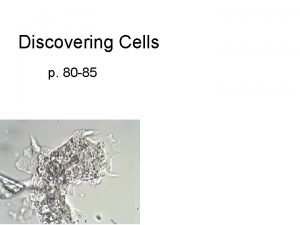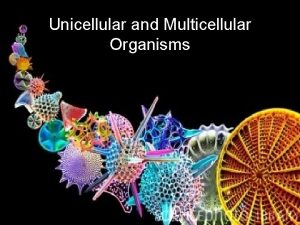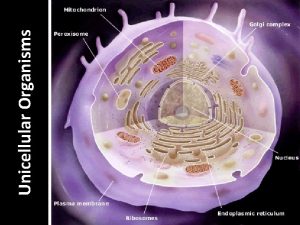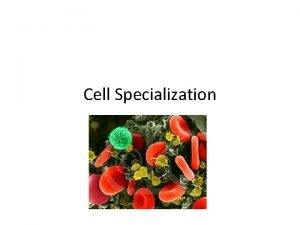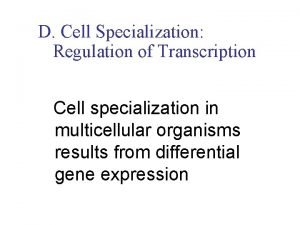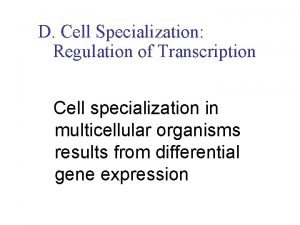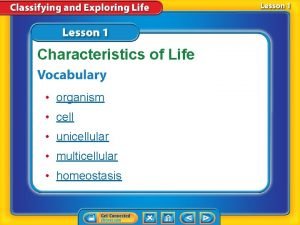Cell Specialization Unicellular Organism consists of only one
















- Slides: 16

Cell Specialization

Unicellular Organism – consists of only one cell - that one cell carries out all functions required to maintain the life of the organism Multicellular Organism – consists of more than one cell - Cells are specialized to perform certain functions (cell specialization/differentiation)

Examples of Cell Specialization 1. Neuron (nerve cell) - sends info from one part of the body to another - very long and thin

Examples of Cell Specialization 2. Red Blood Cells - carry oxygen throughout body - flattened disks so that they can easily flow through blood vessels

Examples of Cell Specialization 3. Sperm Cell - fertilizes egg - strong tail for quick swimming, distinct head for entering egg cell

Cell differentiation is a result of different gene expression.

• Most cells in your body have the same DNA • Cells use only the DNA that they need; the rest is inactive • For example, skin cells use the DNA that codes for melanin (a skin pigment that protects from UV light) • Heart cells do not need melanin, so it is “turned off” in heart cells

Stem Cell Research • stem cells – cells of humans that can develop into different cell types

• 2 kinds: embryonic and adult • some researchers believe that they can be a source of replacement cells to treat disorders (ex. Parkinson’s disease and burn injuries) Embryonic stem cells Adult stem cells

Cell Communication - Cells communicate with one another by secreting and receiving chemicals - Chemicals released by one cell can influence the activity of another cell http: //learn. genetics. utah. edu/content/begin/cells/cellcom/

Example of Cell Communication - Sensory cells to nerve cells to muscle cells http: //bcs. whfreeman. com/thelifewire/content/chp 46/46020. html

Cell Communication (cont. ) Hormone – communication chemicals that travel through the blood (ex. insulin, estrogen) - Secreted by endocrine glands

- Acts much slower than nerve impulses but effects last much longer - Only influence the action of target cells that have specific receptors

Two Hormone Mechanisms 1. Negative Feedback – the end product stops the production of the hormone

Negative Feedback

2. Positive Feedback – the last step triggers more release of the initial hormone or other hormones - triggers a series of events
 Organism that is made up of only one cell
Organism that is made up of only one cell One celled organism name
One celled organism name Unicellular organism
Unicellular organism Unicellular organisms adaptations
Unicellular organisms adaptations Give an example for unicellular organism
Give an example for unicellular organism Unicellular fungi examples
Unicellular fungi examples Why does organism eat another organism
Why does organism eat another organism Unicellular vs multicellular activity
Unicellular vs multicellular activity Correct order from smallest to largest
Correct order from smallest to largest Muscle cell specialization
Muscle cell specialization The two domains composed of only unicellular organisms are
The two domains composed of only unicellular organisms are The only example of unicellular exocrine glands are
The only example of unicellular exocrine glands are Unicellular cell division
Unicellular cell division Multi cellular organism
Multi cellular organism Is a nerve cell multicellular or unicellular
Is a nerve cell multicellular or unicellular Cell tissue organ organ system organism
Cell tissue organ organ system organism Cells group together to form
Cells group together to form
